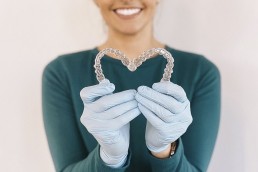Having an opportunity to work with over 19,000 patients across Central Indiana, our orthodontic staff has all seen “the look.” You can’t be in business for 54 years and not see it.
It’s the glazed eye, furrowed brow look of perplexity. It’s the face we all get (and give) when hearing a language we don’t quite understand. And in our offices, it’s the reaction we see from clients after our staff utters a slew of unfamiliar jargon.
We’re guilty of it from time to time. We admit. But we’re also here to help clear up some of the things lost in translation. Below, we’ve compiled an alphabetical list of common terms and phrases in the orthodontic industry—just A to F for now—and tried to explain them in words we all can understand.
– A –
Appliance
No, it’s not countertop equipment designed by Kitchen-Maid. An orthodontic appliance is simply any device we affix to your teeth to realign your jaw and/or adjust the placement of your teeth. Some examples of orthodontic appliances include palatal expanders, quads, lingual holding arches, and retainers.
Archwire
Every mouth has its own unique dental arch—or curve of your jaw from one molar to another. When in braces, this metal wire spans this shape, connects the orthodontic brackets on your teeth, and shifts your teeth into proper place. We tend to replace the archwire periodically throughout your treatment.
– B –
Band
These metal rings fit around your molars—those teeth in the back of your mouth—and secure the base of the archwire (see above) via a safe, oral adhesive application.
Bracket
The archwire wraps around your dental arch and slides into brackets, which are cemented to the front of your teeth. For years, brackets only came in shiny metal materials. But nowadays, Gorman & Bunch Orthodontics patients can select either metal or ceramic brackets in an endless variety of designs and colors.
Prepare Your Child for Their First Orthodontic Appointment
– C –
Coil Spring
When patients require more space between teeth (see crowding below), we fit the coil spring between the target brackets and over your archwire.
Crossbite
With properly aligned jaws, the upper teeth sit slightly over the lower teeth. But with crossbites, the upper teeth are displaced behind the lower teeth or the lower jaw protrudes out beyond the upper jaw (a.k.a. underbite).
Crowding
As the name implies, the term crowding indicates a lack of sufficient space for teeth along the dental arch. Sometimes this occurs when teeth are especially large. But other times, it’s due to a variety of factors such as top or bottom jaws that are too narrow, genetics, thumb sucking as a child that resulted in a narrower dental arch, and more. Crowding can cause some teeth to have inadequate space to come in normally on their own, otherwise known as impacted teeth.
– D –
D.D.S. and D.M.D.
Depending on the dental school, graduates are either awarded their Doctor of Dental Surgery (D.D.S.) degree or Doctor of Medical Dentistry (D.M.D.) degree. (All Gorman & Bunch orthodontists have been awarded D.D.S. degrees.) For orthodontists, it’s the requisite education level between a bachelor’s degree and master’s degree in orthodontics.
Deciduous Teeth
Most often associated with trees or shrubs, the term deciduous simply means “that which falls off.” And so in the dental world, it’s your first set of teeth that eventually fall out—also known as baby or primary teeth.
– E –
Elastics
More commonly referred to as rubber bands, these small elastic rings get hooked by our patients from a bracket on the upper teeth to a bracket on the lower teeth—pulling jaws and teeth into proper alignment.
Expander
Also known as a palatal expander, we secure this device to the upper molars in order to widen the upper jaw (see crossbite definition above). Patients gradually expand their upper palate by inserting a small key into the expander and turning it slightly each day. Patients feel light pressure while turning the expander, but overall it’s a relatively painless process. Watch the short video below to see the process.
– F –
Fixed Retainer
Unlike their cousin appliance that can be quickly and easily removed by patients, the stainless steel fixed retainers get permanently bonded to the backside of the front teeth to prevent teeth shifting over time.
Ready to schedule a free consultation?
April 7, 2020
A diastema, or gap between teeth, is usually a natural part of a child’s development. For many children, the gap between their two front teeth closes with the…
March 4, 2020
We all love a good transformation story, and there’s nothing better than celebrating our patients’ incredible orthodontic treatment journeys. In this post,…
January 15, 2020
The alignment of your teeth can drastically impact your health and overall comfort. If you or your child are consistently experiencing jaw pain, frequent…


